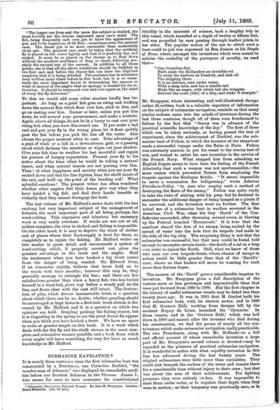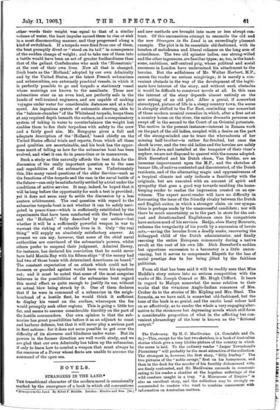SUBMARINE NAVIGATION.*
IT, is nearly three centuries since the first submarine boat was constructed by a Dutchman, one Cornelius Drebbel, " the wonder-man of Alkmaar," who displayed its remarkable quali- ties before our Scottish Solomon in the Thames. James I., who seems for once to. have overcome his constitutional • Submarine Navigation, Past and Present. By Alan H. Burgoyne. London : Grant Richards. [3ls. 6d. net.]
timidity • in the interests of science, took a lengthy trip in- this vessel, which travelled at a depth of twelve or fifteen feet,
and was propelled by oars passing through leather joints in her sides. The popular notion of the use to which such a.
boat could be put was expressed by Ben Jonson in his Skiple of News, where, amongst the inventions which were meant to satirise the credulity of the purveyors of novelty, we read that- " One Cornelius-Son
Hath made the Hollanders an invisible eel To swim the harbour at Dunkirk, and sink all The shipping there It is an automa, runs under water, With a snug nose, and has a nimble tail Made like an anger, with which tail she wriggles
Betwixt the costs [ribs] of a ship, and sinks it straight."
Mr. Burgoyne, whose interesting and well-illustrated, thougn rather ill-written, book is a valuable repertory of information on the subject of submarine navigation, reminds us that many similar notions came into the minds of inventors during the last three centuries, though all of them were foredoomed to failure by the fact that " theory was in advance of the practical scientific knowledge of the day." The first of these which can be taken seriously, as having passed the test of experiment, since the achievement of Drebbel, was the sub- marine boat of Fulton, in which the inventor of the steamboat made a successful voyage under the Seine at Paris. Fulton was extremely anxious to put his vessel to the crucial test of war, and wished to enlist his new invention in the service of the French Navy. What stopped him from attacking an
English frigate seems to have been the feeling of the French Admiralty that such a weapon was not sportsmanlike,—the
same reason which prevented Nelson from employing the torpedo against the Boulogne flotilla. " It seems impossible to serve a commission for belligerency," wrote Admiral Pleville-le-Pelley, "to men who employ such a method of destroying the fleets of the enemy." Fulton was quite ready to take the risks of sinking with his prey, but be declined to encounter the additional danger of being hanged as a pirate if he survived, and the invention went no further. The first actual use of a submarine boat in warfare occurred in the American Civil War, when the tiny ' David' of the Con- federates succeeded, after drowning several crews, in blowing up the Federal ironclad 'Housatonic.' It is true that the assailant shared the fate of its enemy, being sucked by the inrush of water into the hole that its torpedo had made in the side of the big ship. The surprising thing is not that the submarine was successful, but that men could be found bold enough to encounter certain death—the death of a rat in a trap —in order to injure the North. Still, what we know of those who man our own torpedo-boats, whose chance of escape in action would be little greater than that of the 'David's' crew, shows us that leaders will never be wanting for such more than forlorn hopes.
The success of the 'David' gave a considerable impetus to invention. Mr. Burgoyne gives a full description of the
various more or less grotesque and impracticable ideas that were put forward from 1860 to 1890. But the first chapter in the history of useful submarine vessels may be dated less than twenty years ago. It was in 1885 that M. Goubet built his first submarine boat, with its electric motor, and in 1888 that M. Gustave Zede, working from designs left by the
eminent Dupuy de Lome, launched his Gymnote.' In these vessels, and in the ' Gustave Zede,' which was laid down in 1890 and named after the inventor who died during her construction, we find the germs of nearly all the con- trivances which make submarine navigation really practicable.
The two Frenchmen, along with Mr. Holland—to a full and official account of whose remarkable invention a large
part of Mr. Burgoyne's second volume is devoted—may be regarded as the pioneers of practical submarine navigation. It is wonderful to notice with what rapidity invention in this line has advanced during the last twenty years. The original submarines were little more than curiosities. They could sink beneath the surface of the water and remain there for a considerable time without injury to their crew ; but that was about the sum of their achievements. For fighting purposes they were entirely r. s Bless. It was impossible to steer them under water, or to regulate their depth when they were in motion; as their buoyancy was practically zero, or in other words their- weight was equal. to that of a similar volume of water, the least impulse caused them to rise or sink in -a most :disconcerting manner, and they progressed along a kind of switchback. If a torpedo were fired from one of them, the boat promptly dived or " stood on its tail" in consequence of the sudden change of weight ; and to take one of them into a battle would have been an act of greater foolhardiness than that of . the gallant Confederates who sank the Housatonic' at the cost of their own lives. Now all that is changed. Such boats as the Holland,' adopted by our own Admiralty and by the United States, or the latest French submarines and submersibles, are-extremely practical vessels, in which it is perfectly possible to go and torpedo a stationary vessel whose moorings are known to the assailants. These new submarines steer on an even keel, are perfectly safe in the hands of well-trained engineers, and are capable of making voyages under water for considerable distances and at a fair speed. An ingenious system of automatic steering, akin to the "'balance-chamber " of the Whitehead torpedo, keeps them at any required depth beneath the surface, and a compensatory system of taking in water to counterbalance the weight lost enables them to fire their torpedoes with safety to the crew and a fairly good aim. Mr. Burgoyne gives a full and adequate description of the Holland,' based chiefly on the United States official trials and reports, from which all these good qualities are ascertainable, and his book has the oppor- tune merit of telling us how far the submarine boat has been evolved, and what it can do in peace-time or in manoeuvres.
Such a study as this naturally affords the best data for the discussion of the really important question as to the uses and capabilities of the submarine in war. Unfortunately this, like many vexed questions of the elder Service—such as the functions of the torpedo and the ram in the naval battle of the future—can only be satisfactorily settled by atrial under the conditions of active service. It may, indeed, be hoped that it will be long before the opportunity for such a test is provided ; yet it does not seem easy to settle the discussion by a less austere arbitrament. The real question with regard to the submarine torpedo-boat is not whether it can be safely navi- gated in peace-time—which is sufficiently established by the experiments that have been conducted with the French boats and the Holland," fully described by our author—but whether it will be a sufficiently powerful weapon in war to warrant the risking of valuable lives in it. Only " the real thing" will supply an absolutely satisfactory answer. At present we can say, however, that some of the chief naval authorities are convinced of the submarine's powers, whilst others prefer to suspend their judgment. Admiral Dewey, for instance, has declared his conviction that he could never have held Manila Bay with his fifteen ships " if the enemy had had two of those boats with determined Americans on board." The constant expectation of an attack which could not be foreseen or guarded against would have worn his squadron out; and it must be noted that some of the most sanguine believers in the possibilities of the submarine boat regard this moral effect as quite enough to justify its use, without an actual blow being struck by it. One of them declares that if he were in command of a submarine in the neigh- bourhood of a hostile fleet, he would think it sufficient to display his vessel on the surface, whereupon the foe would promptly seek other regions. This is going a little too far, and seems to assume considerable timidity on the part of the hostile commanders. Our own opinion is that the sub- marine has great possibilities before it as an adjunct to coast and harbour defence, but that it will never play a serious part in fleet actions : for it does not seem possible to get over the difficulty of its slowness and blindness under water. But its powers in the former direction are well worth study, and we are glad that our own Admiralty has taken up the submarine, if only to learn how to combat a weapon that must always be the resource of a Power whose fleets are unable to assume the command of the open sea.







































 Previous page
Previous page